
VNU Journal of Science: Earth and Environmental Sciences, Vol. 39, No. 4 (2023) 16-31
16
Original Article
Geological History of Caves and Conservation Values
of the World Nature Heritage Phong Nha-Ke Bang
National Park
Tran Nghi1, Le Nam2, Dao Bui Din2, Dinh Xuan Thanh1,
Ta Hoa Phuong1, Dang Van Bao1, Nguyen Thi Huyen Trang1,*
1VNU University of Science, 334 Nguyen Trai, Thanh Xuan, Hanoi, Vietnam
2Ministry of Natural Resources and Environment, 10, Ton That Thuyet, Hanoi, Vietnam
Received 05 August 2023
Revised 03 October 2023; Accepted 27 November 2023
Abstract: The long development history and geological diversity of the Phong Nha-Ke Bang area
is shown by the rich and diverse lithological composition of the stratigraphic units ranging in age
from Devonian to Present day: granite, terrigenous rock, thin-bedded limestone, and massive
limestone. The geomorphology of the national park includes limestone mountain terrain alternating
with terrigenous rock mountain terrain surrounding the karst valley system. The formation of the
cave is an endogenous-exogenous geological process that occurs according to the cycle of global
sea level change. The tectonic activity is the mother that gives birth to the caves of different heights
and ages. The higher the cave, the older it is, and the oldest cave is 32 million year old-Khe Ry cave.
The four fault systems of Northeast - Southwest (NE-SW), Northwest - Southeast (NW-SE), West -
East (WE), and North - South (NS) create four cave systems that are deep faults with strong
destructive intensity. Exogenous geological activities in the cave have created a uniquely beautiful
landscape including three simultaneous processes: i) Chemical washing of driftwood, mechanical
abrasion, polishing of the cave walls, and ceiling caused by travertine floods pouring into it from
outside the cave; ii) Precipitation forming stalactites from the ceiling of the cave and precipitation
forming stalagmites from the floor of the cave slowly over millions of years; and iii) Travertine
sedimentation on the cave floor resulting in many unique sedimentary bodies, specifically filling the
rough terrain of limestone blocks, covering the ancient stalactites falling from the cave ceiling,
forming spiral mushroom island in the Son Doong cave, and creating gem pebbles located in fan-
shaped sunken cells of the cave.
Keywords: Diversity, faults, endogenous-exogenous geology, stalactites, stalagmites, cave gems.*
________
* Corresponding author.
E-mail address: nguyentrang181@gmail.com
https://doi.org/10.25073/2588-1094/vnuees.4971

T. Nghi et al. / VNU Journal of Science: Earth and Environmental Sciences, Vol. 39, No. 4 (2023) 16-31
17
Lịch sử địa chất hang động và những giá trị di sản
tiêu biểu của vườn quốc gia Phong Nha - Kẻ Bàng
Trần Nghi1, Lê Nam2, Đào Bùi Din2, Đinh Xuân Thành1,
Tạ Hoà Phương1, Đặng Văn Bào1, Nguyen Thi Huyen Trang1,*
1Trường Đại học Khoa học Tự nhiên, Đại học Quốc gia Hà Nội,
334 Nguyễn Trãi, Thanh Xuân, Hà Nội, Việt Nam
2Bộ Tài nguyên và Môi trường, 10 Tôn Thất Thuyết, Hà Nội, Việt Nam
Nhận ngày 05 tháng 8 năm 2023
Chỉnh sửa ngày 03 tháng 10 năm 2023; Chấp nhận đăng ngày 27 tháng 11 năm 2023
Tóm tắt: Lịch sử phát triển lâu dài và tính đa dạng về địa chất của khu vực phong Nha-Kẻ Bàng
được thể hiện bởi thành phần thạch học phong phú và đa dạng của hầu hết các phân vị tầng có tuổi
từ Devon đến nay: đá magma granit, đá lục nguyên, đá vôi phân lớp mỏng và đá vôi dạng khối. Tính
đa dạng của địa mạo thể hiện địa hình karst xen kẽ địa hình núi đá lục nguyên nằm bao quanh hệ
thống thung lũng karst. Lịch sử tạo hang động là quá trình địa chất nội-ngoại sinh diễn ra theo chu
kỳ thay đổi mực nước biển toàn cầu. Hoạt động kiến tạo là người mẹ khai sinh ra các hang động có
độ cao khác nhau và tuổi khác nhau. Hang càng cao có tuổi càng cổ và hang cổ nhất là hang Khe Ry
có tuổi 32 triệu năm. Bốn hệ thống đứt gãy Đông Bắc - Tây Nam (ĐB-TN), Tây Bắc - Đông Nam
(TB-ĐN), Đông - Tây (ĐT) và Bắc - Nam (BN) tạo ra 4 hệ thống hang động là những đứt gãy sâu
có cường độ phá huỷ mạnh. Hoạt động địa chất ngoại sinh trong hang động đã tạo nên phong cảnh
đẹp độc đáo bao gồm 3 quá trình xẩy ra đồng thời: i) Quá trình rửa lũa bằng phương thức hoá hoc
và mài mòn đánh bóng cơ học vách hang và trần hang do các dòng lũ travertin từ ngoài hang đổ vào;
ii) Quá trình kết tủa tạo thạch nhũ từ trần hang xuống và kết tủa tạo măng đá từ sàn hang lên từ qua
hàng triệu năm đã tạo nên các tiên cảnh kỳ thú; và iii) Quá trình trầm tích travertin trên sàn hang đã
tạo ra nhiều thể trầm tích độc đáo: lấp nhét địa hình gồ ghề của các khối tảng đá vôi; phủ trên các
khối tảng thạch nhũ cổ rơi từ trần hang xuống; thành tạo đảo nấm hình xoáy ốc ở hang Sơn Đoòng;
tạo các cuội ngọc động nằm trong các ô trũng hình rẽ quạt.
Từ khoá: Đa dạng, đứt gãy, địa chất nội – ngoại sinh, thạch nhũ, măng đá, ngọc động.
1. Mở đầu*
Tháng 7 năm 2003 UNESCO công nhận di
sản thiên nhiên thế giới vườn quốc gia Phong
Nha - Kẻ Bàng Quảng Bình Việt Nam. Đây là di
sản thiên nhiên thế giới thứ 2 sau Vịnh Hạ Long.
Để có được kết quả đáng tự hào đó không thể
không nói đến những đóng góp của nhân dân địa
________
* Tác giả liên hệ.
Địa chỉ email: nguyentrang181@gmail.com
https://doi.org/10.25073/2588-1094/vnuees.4971
phương Quảng Bình về sự khám phá tìm tòi
những bí mật nơi chôn rau cắt rốn. Có thể chia ra
2 giai đoạn nối tiếp nhau: i) Giai đoạn 1: là giai
đoạn thám hiểm hang động bắt đầu từ năm 1991
đến năm 1995 phối hợp giữa Hội hang động
Hoàng Gia Anh và nhóm cán bộ khoa học của
Khoa Địa lý-Địa chất, Trường Đại học Tổng hợp
Hà Nội; và ii) Giai đoạn 2 là giai đoạn vừa tiếp

T. Nghi et al. / VNU Journal of Science: Earth and Environmental Sciences, Vol. 39, No. 4 (2023) 16-31-8
18
tục thám hiểm vừa nghiên cứu khoa học để xây
dựng “Hồ sơ di sản thiên nhiên thế giới”.
Người Quảng Bình gọi động Phong Nha là
“Chùa Hang” vì sự kì bí và linh thiêng của nó.
Chùa hang đã được dân địa phương phát hiện từ
lâu đời nhưng công cuộc thám hiểm của họ chỉ
bằng đốt đuốc để soi sáng đường đi theo hang.
Vì vậy thám hiểm này mang tính chất tò mò theo
thị hiếu đơn giản nên không được ghi chép đo
đạc và chụp ảnh có giá trị như các tư liệu, số liệu
để lại cho con cháu đời sau. Sau đó Pháp lại tiếp
tục thám hiểm và đến năm 1937 phòng du lịch
của toà Khâm Sứ Pháp ở Huế đã xuất bản một tờ
gấp nhỏ giới thiệu du lịch tỉnh Quảng Bình trong
đó có động Phong Nha. Tuyến du lịch Phong Nha
được Pháp xếp vào hạng thứ 2 ở Đông Dương.
Năm 1965 đoàn địa chất 20 thuộc Tổng Cục
Địa chất Việt Nam đã thành lập “Bản đồ địa chất
khu vực tỉnh Quảng Bình tỷ lệ 1/500.000” thuộc
một phần bản đồ địa chất miền Bắc Việt Nam tỷ lệ
1/500.000 do Dovjicov (Liên Xô cũ) chủ biên [1].
Năm 1980 Nguyễn Quang Trung (chủ biên)
đã thành lập “Bản đồ địa chất và khoáng sản tờ
Maxay-Đồng Hới tỷ lệ 1/200.000 [2].
Năm 1980, 1997 các công trình nghiên cứu
về địa tầng Devon và ranh giới Frasni-Famen
do Nguyễn Hữu Hùng, Tạ Hoà Phương và nnk
thực hiện ở khu vực Quỳ Đạt và Phong Nha -
Kẻ Bàng [3].
Các công trình nói trên đã có những đóng
góp quan trọng giúp tác giả của hồ sơ hoàn thiện
tính đa dạng địa chất, địa mạo và lịch sử phát
triển lâu dài của vỏ Trái đất ở khu vực phong Nha
-Kẻ Bàng: i) Bản đồ địa chất của Dovjicov chủ
biên (1965) và bản đồ địa chất của Nguyễn
Quang Trung chủ biên (1980) đã thể hiện 4 hệ
thống đứt gãy có 4 phương trùng với 4 phương
của hang động Phong Nha - Kẻ Bàng được tạo
thành do các đứt gãy ngầm trong lòng các khối
núi đá vôi; và ii) Công trình của Nguyễn Hữu
Hùng và Tạ Hoà Phương (1980,1997) đã chính
xác hoá ranh giới Frasni-Famen của địa tầng
Devon khu vực Phong Nha-Kẻ bàng để làm tăng
tính đa dạng địa chất và thang địa tầng có tính
liên tục từ Ordovic-Silur đến trầm tích Đệ Tứ.
Năm 1990 lần đầu tiên có sự hợp tác thám
hiểm hang động giữa Khoa Địa lý-Địa chất,
Trường Đại học Tổng hợp Hà Nội và Hội hang
động Hoàng Gia Anh do Howard Limbert thám
hiểm được 3 km ở động Phong Nha và Hang
Vòm. Từ năm 1992 đến 1999 đã khảo sát được
23 km gồm các hang: Phong Nha (7729 m); hang
Khe Ry (18902 m; hang Én (1642 m); hang Rục
Cà Ròong (2800 m); hang Người Lùn 865 m;
hang Vượt (3244 m); hang Hổ (1616 m); hang
Đại Cáo (1607 m); hang Tiên (2481 m).
Từ 1991 đến 1996 các công trình nghiên cứu
về địa chất Đệ Tứ các cồn cát và đồng bằng ven
biển và biển nông ven bờ tỉnh Quảng Bình do
Trần Nghi chủ trì đã có những phát hiện mới về
địa tầng và lịch sử phát triển địa chất Đệ Tứ góp
phần nâng cao chất lượng của hồ sơ di sản [4, 5].
Năm 2008 và năm 2010 một nhóm các nhà
khoa học Việt Nam và thanh niên địa phương đã
dẫn Howard Limbert và cộng sự vào thám hiểm
hang Sơn Đoòng và đã đưa hang Sơn Đoòng vào
danh sách một trong những hang đẹp và kỳ vĩ
nhất thế giới.
Những kết quả thám hiểm hang động của
Howard Libert là một trong các dữ liệu quan
trọng đã giúp các nhà địa chất địa mạo tiếp tục
nghiên cứu và chứng minh một cách thuyết phục
các tiêu chí yêu cầu của UNESCO và đã xây
dựng thành công hồ sơ di sản thiên nhiên thế giới
vườn quốc gia Phong Nha-Kẻ Bàng, Quảng Bình
Việt Nam.
Lịch sử xây dựng hồ sơ di sản thiên nhiên thế
giới vườn quốc gia Phong Nha-Kẻ Bàng có thể
tóm tắt như sau:
Năm 1986 khu động Phong Nha đã được
Chính phủ nước Cộng hoà Xã hội Chủ nghĩa Việt
Nam xếp hạng di sản quốc gia đặc biệt quan
trọng theo quyết định số 194/CP của Thủ tướng
Chính phủ;
Năm 1993 khu bảo tồn thiên nhiên Phong
Nha được chính thức thành lập với diện tích
41132 ha.
Năm 1997 “Dự án xây dựng vườn quốc gia
Phong Nha - Kẻ Bàng giai đoạn 2000-2005 bao
gồm toàn bộ vùng núi đá vôi Phong Nha - Kẻ
Bàng và hệ thống hang động trong khu vực với
tổng diện tích khoảng 147945 ha.
Năm 1999 theo yêu cầu của UNESCO cần
nghiên cứu bổ sung hoàn chỉnh hồ sơ Di sản

T. Nghi et al. / VNU Journal of Science: Earth and Environmental Sciences, Vol. 39, No. 4 (2023) 16-31
19
thiên nhiên thế giới đối với vườn quốc gia Phong
Nha-Kẻ Bàng, Trường Đại học Khoa học Tự
nhiên đã giao cho Giáo sư Trần Nghi chủ trì và
2 cộng sự là Giáo sư Tạ Hoà Phương chuyên gia
nghiên cứu về Địa tầng và Phó giáo sư Đặng Văn
Bào chuyên gia nghiên cứu về Địa mạo đã triển
khai thực hiện từ 1999 đến 2001. Hồ sơ là một
công trình nghiên cứu khoa học đã chứng minh
đầy đủ 5 vấn đề quan trọng: i) Đa dạng địa chất-
địa mạo và lịch sử phát triển vỏ Trái Đất lâu dài;
ii) Chứng minh hang động có tuổi cổ và phân biệt
tuổi của các thế hệ hang; iii) Tính độc đáo và cơ
chế hình thành danh lam thắng cảnh của hang
động; và iv) Đa dạng sinh học và những loài
động thực vật đang có nguy cơ tiệt chủng.
Năm 1999 hồ sơ “Di sản thiên nhiên thế giới
vườn quốc gia Phong Nha-Kẻ Bàng” bắt đầu
nghiên cứu và xây dựng lại từ đầu bám sát 5 tiêu
chí do UNESCO yêu cầu dưới sự chủ trì của GS
Trần Nghi, bao gồm: i) Tính đa dạng địa chất;
ii) Lịch sử phát triển lâu dài của vỏ Trái Đất
manh tính chất toàn cầu; iii) Tính đa dạng về địa
hình-địa mạo; iv) Lịch sử địa chất hình thành
hang động và các phong cảnh đa dạng và độc
đáo; và v) Chứng minh được tuổi hang động phải
cổ. Đây là một nhiệm vụ hết sức quan trọng và
cấp thiết tuy nhiên cũng là bài toán khó bởi
những áp lực không nhỏ đối với nhóm tác giả
trước đấy đã có một nhóm nghiên cứu xây dựng
hồ sơ di sản nhưng hội đồng di sản UNESCO bỏ
phiếu không đạt. Điều đó đòi hỏi nhóm nghiên
cứu sau phải hết sức cẩn trọng nghiên cứu kỹ các
tiêu chí yêu cầu của UNESCO và lý do hồ sơ bị
loại để bổ sung hoàn chỉnh hồ sơ. Như vậy muốn
hoàn thành được hồ sơ theo yêu cầu của
UNESCO tất yếu phải là các nhà địa chất đặc biệt
phải có nhà địa chất Trầm tích thì mới nghiên
cứu và làm sáng tỏ được cơ chế hình thành hang
động không phải là do “nước chảy đá mòn” như
một số nhà địa lý của thế giới quan niệm mà đó
là một quá trình hoạt động địa chất nội sinh và
ngoại sinh lâu dài bắt đầu từ 32 triệu năm. Tính
đa dạng của địa chất được thể hiện không chỉ là
đặc điểm cấu trúc địa chất và sự có mặt phong
phú các loại đá từ khối granit Đồng Hới đến các
đá phiến của hệ tầng Khâm Đức, các đá trầm tích
lục nguyên tuổi Ordovic-Silur, cuội sạn kết tuổi
Creta của hệ tầng Mụ Giạ, đá vôi dạng turbidit
và đá vôi platform tuổi Carbon -Permi kỳ vĩ như
một hoang mạc lớn nhất thế giới. Đến giai đoạn
Kainozoi bối cảnh địa chất của khu vực Phong
Nha-Kẻ Bàng lại bị thay đổi và kiến lập nên sự
đa dạng về địa hình - địa mạo và phong cảnh độc
đáo đa dạng bên trong các hang động. Nhóm
nghiên cứu đã chứng minh được hang động
Phong Nha-Kẻ Bàng là cổ nhất Đông Nam Châu
Á. Thế hệ hang đầu tiên có tuổi 32 triệu năm cùng
tuổi với pha tách giãn đầu tiên của đáy Biển Đông.
Có một số cong trình trích dẫn mang tính liệt
kê, chưa có đánh giá. Các công trình nghiên cứu
cần trình bầy theo trật tự thời giân.
2. Phương pháp luận và phương pháp
nghiên cứu
2.1. Phương pháp luận
Nghiên cứu địa chất hang động phải tiếp cận
theo quan điểm hệ thống, lịch sử, nhân-quả, tiến
hoá chu kỳ và đối sánh.
Quan điểm hệ thống là tư tưởng xuyên suốt
trong lịch sử hoạt động địa chất nội sinh và ngoại
sinh. Mối quan hệ này chỉ nhìn thấy được qua
hiện diện của các sản phẩm di chỉ địa chất nhìn
thấy được trên bề mặt Trái Đất. Trong hang động
thấy rõ các khối đá vôi có kích thước từ nửa mét
đến hàng chục mét được phủ bởi các lớp trầm
tích travertin phân lớp mỏng đó là kết quả của 2
quá trình nội sinh và ngoại sinh. Quá trình địa
chất nội sinh được thể hiện bởi sự hiện diện của
các khối tảng đá vôi. Chúng là sản phẩm của đứt
gãy sâu phá huỷ các núi đá vôi theo 3 chiều: cao-
sâu, rộng và dài. Đứt gãy sâu mới có không gian
để tất cả các khối đá vôi bị phá huỷ rơi xuống và
lấp kín vào khoảng trống phía dưới đồng thời tạo
ra khoảng không phía trên đó chính là hang động.
Travertin phủ trên các khối tảng đá vôi là sản
phẩm của quá trình địa chất ngoại sinh. Chúng là
vật liệu bùn cát lục nguyên tha sinh trộn với
mảnh vụn đá vôi được gắn kết bởi carbonat calci
kết tủa từ bicarbonat quá bão hoà luôn luôn tồn
tại trong dòng bùn đá travertin.
Tiếp cận lịch sử là khi quan sát một hang
động nào đó phải nhìn thấy chúng là một bức

T. Nghi et al. / VNU Journal of Science: Earth and Environmental Sciences, Vol. 39, No. 4 (2023) 16-31-8
20
tranh sinh động ghi lại các quá trình lịch sử địa
chất nội sinh và ngoại sinh từ khi bắt đầu các hoạt
động đứt gãy tạo hang đến các chu kỳ gia công
chế tác và tô điểm của địa chất ngoại sinh trong
mối quan hệ với các chu kỳ biển tiến và biển
thoái. Đấy là tiêu chí về tuổi của hang động mà
UNESCO yêu cầu. Khi thám hiểm hay quá trình
nghiên cứu khảo sát rất dễ dàng phát hiện được
các thế hệ hang treo, hang khô nằm trên lưng
chừng núi hoặc các hang ngầm dưới mặt đất. Để
trả lời câu hỏi tại sao lại như vậy? và chúng được
sinh ra từ lúc nào? thì không đơn giản. Đó chính
là một trong những bí quyết mà nhóm xây dựng
hồ sơ di sản thiên nhiên thế giới vườn quốc gia
Phong Nha-Kẻ Bàng Quảng Bình Việt Nam đã
giải mã thành công.
Tiếp cận nhân quả và tiến hoá là tư duy triết
học đó là quy luật biện chứng. Quá trình tiến hoá
của vỏ Trái Đất được biểu đạt ra các đối tượng
địa chất khác nhau. Hang động là một đối tượng
địa chất độc đáo. Quá trình địa chất hang động
diễn ra theo quy luật nhân-quả và tiến hoá trong
mối quan hệ với 5 chu kỳ kiến tạo trong Đệ Tam
và 8 chu kỳ biến đổi khí hậu và thay đổi mực
nước biển trong Pliocen-Đệ Tứ liên quan đến
chu kỳ băng hà/gian băng.
2.2. Phương pháp nghiên cứu
Các phương pháp nghiên cứu địa chất karst
hang động là chìa khoá thành công của hồ sơ di
sản thiên nhiên thế giới Phong Nha-Kẻ Bàng
bao gồm:
2.2.1. Phương pháp phân tích đứt gãy
- Đối sánh phương đứt gãy và phương chạy
của hang: khu vực Phong Nha-Kẻ Bàng có 4 hệ
thống hang chạy theo 4 phương đứt gãy:
i) Phương ĐB-TN: sông Son, sông Chày, hang
Vòm, hang Khe Ry; ii) Phương TB-ĐN: hang
Đại Cáo, hang Pygmy, hang Lạnh; iii) Phương
BN: hang Phong Nha, hang Sơn Đoòng; và iv)
Phương ĐT: hang Thung, hang Va (Hình 11).
- Những bằng chứng hang là kết quả ủa đứt
gãy: i) Trần hang phát triển thạch nhũ chạy theo
tuyến song song với hang; ii) Trần hang có Hình
2 mái nhà khép lại tựa như nóc mái nhà chạy dọc
theo hang cùng với hệ thống khe nứt chạy song
song với khe nứt nóc hang; và iii) Sàn hang ngổn
ngang khối tảng đá vôi cùng thành phần với núi
đá vôi Carbon-Permi dạng khối là bằng chứng
của đứt gãy phá huỷ sâu.
2.2.2. Phương pháp phân tích thạch học
Phương pháp nghiên cứu thạch học ngoài
trời và thạch học lát mỏng trong phòng thí
nghiệm đã chứng minh cho tính đa dạng của địa
chất trong khu vực vườn quốc gia Phong Nha-
Kẻ Bàng. Các loại đá khu vực Phong Nha-Kẻ
Bàng đã được xác định, bao gồm: i) Đá cát kết,
bột kết, đá phiến sét tuổi Ocdovic muộn-Silua
sớm hệ tầng Long Đại (O3-S1lđ); ii) Đá vôi chứa
silic dạng ổ tuổi Devon sớm hệ tầng Rào Chan
(D1rc); iii) Đá vôi phân lớp mỏng xen silic tuổi
Devon muộn-Carbon sớm hệ tầng Phong Nha
(D3-C1pn); iv) Đá vôi dạng khối tinh khiết hệ
tầng Bắc Sơn (C-Pbs); v) Đá lục nguyên hệ tầng
Khe Giữa (P2kg); vi) Cuội kết, sạn kết và cát bột
kết tuổi Creta hệ tầng Mụ Giạ (Kmg); và vii) Cát
bột kết tuổi Neogen hệ tầng Đồng Hới (Nđh) và
5 hệ tầng trầm tích Đệ Tứ bở rời (Q) phân bố trên
các thềm, bãi bồi sông miền núi, đồng bằng
sông-lagoon ven biển và các cồn cát thạch anh
ven biển.
2.2.3. Phương pháp nghiên cứu địa mạo
nguồn gốc và địa mạo lịch sử
Phương pháp nghiên cứu địa mạo nguồn gốc
đã chứng minh được tính đa dạng về địa hình và
địa mạo khu vực Phong Nha-Kẻ Bàng. Phương
pháp này chủ yếu nghiên cứu ngoài thực địa và
giải đoán ảnh viễn thám bao gồm 2 bước: i) Bước
1: nghiên cứu thực địa: quan sát địa hình và
thành phần thạch học liên quan, đo độ dốc mỗi
kiểu địa hình, mạng lưới thuỷ văn và chụp ảnh
địa hình; và ii) Bước 2: nghiên cứu trong phòng:
giải đoán ảnh viễn thám để chính xác hoá phân
loại địa hình địa mạo theo quan điểm địa mạo
nguồn gốc và địa mạo lịch sử.
2.2.4. Phương pháp xác định tuổi của hệ
thống hang động
Tuổi của hệ thống hang động Phong Nha -
Kẻ Bàng được xác định dựa trên 3 bước: i) Xác
định độ cao, độ sâu của tất cả các hang và ngấn
biển so với mực nước biển hiện đại; và ii) Phân



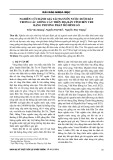
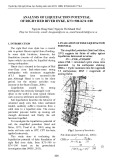

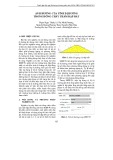
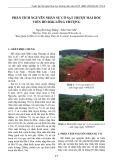
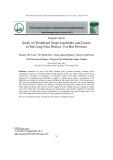
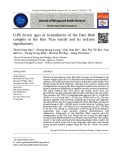




![Quy hoạch tổng thể Cà Mau: Tài liệu [mới nhất/chuẩn nhất]](https://cdn.tailieu.vn/images/document/thumbnail/2025/20250827/tghong1621@gmail.com/135x160/49401756278390.jpg)


![Bài giảng Hàng hải địa văn [chuẩn nhất]](https://cdn.tailieu.vn/images/document/thumbnail/2025/20250729/vijiraiya/135x160/43361753782101.jpg)
![Bài giảng Trắc địa cơ sở [mới nhất]](https://cdn.tailieu.vn/images/document/thumbnail/2025/20250729/vijiraiya/135x160/84_bai-giang-trac-dia-co-so.jpg)





![Atlas tài nguyên nước Việt Nam: Tài liệu [Mô tả/Hướng dẫn/Chi tiết]](https://cdn.tailieu.vn/images/document/thumbnail/2025/20250715/vijiraiya/135x160/348_tai-lieu-atlas-tai-nguyen-nuoc-viet-nam.jpg)
![Hệ thống câu hỏi ôn tập Vùng kinh tế [chuẩn nhất]](https://cdn.tailieu.vn/images/document/thumbnail/2025/20250709/kimphuong1001/135x160/76921752140578.jpg)
